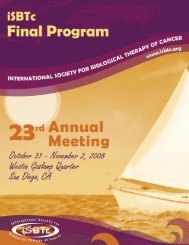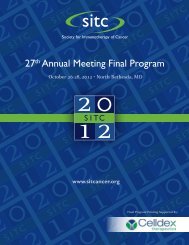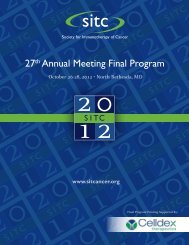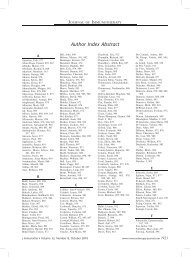Abstracts for the 25th Annual Scientific Meeting of the International ...
Abstracts for the 25th Annual Scientific Meeting of the International ...
Abstracts for the 25th Annual Scientific Meeting of the International ...
Create successful ePaper yourself
Turn your PDF publications into a flip-book with our unique Google optimized e-Paper software.
J Immuno<strong>the</strong>r Volume 33, Number 8, October 2010<br />
<strong>Abstracts</strong><br />
additionally <strong>the</strong> presentation <strong>of</strong> <strong>for</strong>eign viral proteins toge<strong>the</strong>r with<br />
tumour antigens, promoting adaptive anti-tumour immune responses.<br />
We have shown induction <strong>of</strong> an immune response by using<br />
Vesicular Stomatitis Virus (VSV) as an adjuvant in a tumour lysate<br />
vaccine setting. We hypo<strong>the</strong>size that <strong>the</strong> treatment <strong>of</strong> tumours prior<br />
to surgical resection will generate an in situ anti-tumour immune<br />
response which may protect immune competent hosts from<br />
recurrence or metastasis.<br />
Methods: Donor mice are injected with 1 10 4 6 CT26lacZ tumour<br />
cells subcutaneously into both flanks on day -14. Mice are<br />
euthanized on day 0 at which point <strong>the</strong> tumours are removed.<br />
Recipient mice receive 1 1 mm CT26lacZ tumour implants<br />
subcutaneous in <strong>the</strong> flank. Mice are treated with PBS or<br />
5 10 4 8pfu VSV51ÄGMCSF intravenous prior to complete<br />
surgical resection <strong>of</strong> <strong>the</strong> flank tumour. Mice are <strong>the</strong>n challenged<br />
with 1 10 4 6 CT26lacZ cells subcutaneous on <strong>the</strong> opposite flank,<br />
and tumour growth and rate is recorded.<br />
Results: We developed a CT26lacZ surgical model <strong>of</strong> cancer, where<br />
mice that received a 1 1 mm tumour implant from donor mice<br />
grew <strong>the</strong> challenge tumour more consistently compared to mice<br />
that received a subcuteneous injection <strong>of</strong> CT26lacZ cells (no treatment).<br />
We found that mice treated with PBS or VSVD51GMCSF<br />
prior to surgical resection were not protected against <strong>the</strong>ir<br />
challenge tumour. Mice that were treated with VSVD51GMCSF<br />
without surgical removal <strong>of</strong> <strong>the</strong> primary tumour were protected<br />
against <strong>the</strong> challenge tumour. On <strong>the</strong> contrary, mice that were<br />
treated with VSVD51GMCSF and received a mock surgery or<br />
complete surgical resection were not protected against <strong>the</strong>ir<br />
challenge tumour.<br />
Conclusions and Discussion: Our data demonstrates that surgical<br />
stress abrogates protection against <strong>the</strong> challenge tumour and<br />
<strong>the</strong>re<strong>for</strong>e <strong>the</strong> anti-tumour immune response generated by<br />
VSVD51GMCSF treatment. Surgical stress can induce immunosuppression<br />
or tumour growth facilitation. We are currently<br />
characterizing this period <strong>of</strong> surgical stress, and we are also aiming<br />
to overcome this stressed state by altering viral treatment regimens<br />
and route <strong>of</strong> administration.<br />
The Immune Enhancing Effects <strong>of</strong> IL-7 on Human T Cells<br />
are Due to Activation <strong>of</strong> Stat Signaling but Not Repression <strong>of</strong><br />
Cbl-b<br />
Guen<strong>the</strong>r Lametschwandtner*, Thomas Gruberw, Gottfried Baierw,<br />
Dominik Wolfz, Isabella Haslinger*, Manfred Schuster*,<br />
Hans Loibner*. *Apeiron Biologics AG, Vienna; w Experimental<br />
Cell Genetics Unit; zTyrolean Cancer Research Institute, Innsbruck<br />
Medical University, Innsbruck, Austria.<br />
The E3 ubiquitin ligase Cbl-b plays a key role <strong>for</strong> anti-tumor<br />
immune responses, as cbl-b deficient mice are protected against<br />
different tumors and cbl-b deficient CD8 T cells efficiently reject<br />
tumors. We have recently shown that transient silencing <strong>of</strong> cbl-b in<br />
human T cells was able to reproduce <strong>the</strong> phenotype <strong>of</strong> cbl-b<br />
deficient murine T cells, validating cbl-b as target <strong>for</strong> cancer<br />
immuno<strong>the</strong>rapy. Very recently, IL-7 has been described to control<br />
cbl-b expression and adjuvant IL-7 improved antitumor responses<br />
in murine models. We have <strong>the</strong>re<strong>for</strong>e investigated whe<strong>the</strong>r IL-7<br />
treatment <strong>of</strong> human T cells induces comparable biological effects as<br />
described <strong>for</strong> murine T cells. Cbl-b silencing or IL-7 treatment<br />
enhanced proliferation <strong>of</strong> TCR-stimulated CD4 and CD8 cells and<br />
induced increased production <strong>of</strong> IFN-g, TNF-a and IL-2.<br />
However, IL-7 treatment <strong>of</strong> cbl-b silenced T cells induced similar<br />
effects, suggesting mechanistic independence from cbl-b. Accordingly,<br />
IL-7 treatment <strong>of</strong> human CD4 and CD8 T cells did not<br />
modulate cbl-b expression. We next tested <strong>the</strong> role <strong>of</strong> STAT<br />
factors, as IL-7 is a member <strong>of</strong> <strong>the</strong> common cytokine receptor g-<br />
chain family (gc), which are known to signal via STAT transcription<br />
factors. Indeed, IL-7 induced STAT5 phosphorylation in<br />
human CD4 and CD8 T cells although with kinetic differences: in<br />
CD8 T cells STAT5 phosphorylation peaked earlier and declined<br />
more rapidly as compared to CD4 T cells. In agreement, <strong>the</strong><br />
enhancement <strong>of</strong> cytokine production showed similar differences.<br />
IL-2, ano<strong>the</strong>r member <strong>of</strong> <strong>the</strong> gc cytokine family, is clinically used as<br />
immune stimulant in cancer <strong>the</strong>rapy. Thus, we have directly<br />
compared <strong>the</strong> effects <strong>of</strong> IL-2 and IL-7 on human immune cells. Like<br />
IL-7, IL-2 did not modulate cbl-b expression, but both cytokines<br />
induced STAT5 phosphorylation and enhanced proliferation and<br />
cytokine production. However, IL-7 failed to support <strong>the</strong> growth <strong>of</strong><br />
human CD8 cells as efficiently as IL-2 did. Moreover, IL-2 but not<br />
IL-7 was able to activate human NK cells, thus suggesting that IL-7<br />
will not have superior effects over IL-2 in clinically applied immune<br />
<strong>the</strong>rapies against tumors. In conclusion, we show here that IL-7<br />
does not modulate cbl-b expression in human T cells and <strong>the</strong>re<strong>for</strong>e<br />
findings in <strong>the</strong> murine system using IL-7 might not be directly<br />
translatable into <strong>the</strong> clinic. In contrast, interventions targeting cblb<br />
have identical effects in murine and human T cells and thus seem<br />
to be a more promising strategy to enhance immune cell-mediated<br />
reactivity targeting tumors in vivo.<br />
Ovarian Cancer Cells Ubiquitously Express HER-2 and can<br />
be Distinguished from Normal Ovary by Genetically<br />
Redirected T Cells<br />
Evripidis Lanitis*w, Ian Hagemannz, Degang Song*, Lin Zhang*,<br />
Richard Carrolly, Raphael Sandaltzopoulosw, George Coukos*,<br />
Daniel J. Powell Jr*. *OCRC, UPENN; zPathology & Lab<br />
Medicine, UPENN; yAFCRI, UPENN, Philadelphia, PA; w MBG,<br />
Democritus University <strong>of</strong> Thrace, Alexandroupolis, Greece.<br />
Background: HER-2-specific T cells can be induced by vaccination<br />
or generated de novo by genetic engineering, however it remains<br />
uncertain to what extent T cell-based HER-2-directed immuno<strong>the</strong>rapy<br />
can be utilized <strong>for</strong> <strong>the</strong> treatment <strong>of</strong> advanced ovarian<br />
cancer.<br />
Objective: To validate HER-2 as a well-suited tumor antigen <strong>for</strong><br />
widespread T cell-based adoptive immuno<strong>the</strong>rapy <strong>of</strong> ovarian cancer.<br />
Methods: HER-2 expression was first evaluated using immunohistochemical<br />
analysis (IHC) in 50 high-grade ovarian serous<br />
carcinomas. To determine <strong>the</strong> relative expression <strong>of</strong> HER-2 in<br />
ovarian cancer cell lines, patient tumor samples and normal<br />
ovarian surface epi<strong>the</strong>lial cells (OSE), Q-PCR, FACS and western<br />
blot was per<strong>for</strong>med. Human T cells were genetically engineered to<br />
express <strong>the</strong> C6.5 HER-2-specific chimeric immune receptor (CIR).<br />
HER-2-redirected T cells were tested <strong>for</strong> <strong>the</strong>ir capacity to recognize<br />
and kill HER-2 expressing tumors and OSE cells.<br />
Results: IHC analysis showed HER-2 expression in 52% <strong>of</strong> primary<br />
OvCas; 26 cases had HER-2 expressed at one or more tumor sites<br />
while HER-2 was undetectable in 24 samples. However, Q-PCR,<br />
FACS and western blot analysis demonstrated HER-2 expression<br />
in all established ovarian tumors (13/13) and short-term cultured<br />
tumors (7/7). Consistent with <strong>the</strong>se results, all tumor cells derived<br />
from primary ascites (24/24) and solid tumor (12/12) expressed<br />
HER-2, albeit at variable levels. Compared to tumor, all (n = 4)<br />
normal OSE expressed lower but detectable HER-2 levels.<br />
Genetically redirected T cells recognized and reacted against all<br />
ovarian cancer cell lines (14/14), primary ascites (5/5) and solid<br />
tumor (5/5) tested, however little or no reactivity was observed<br />
against normal OSE (1/4).<br />
Conclusions: Our results show that IHC under represents <strong>the</strong><br />
frequency <strong>of</strong> OvCas that express/overexpress HER-2 which may<br />
exclude patients with low HER-2 expressing tumors from receiving<br />
HER-2 targeted <strong>the</strong>rapy. Utilizing more sensitive detection<br />
methods, we found that OvCas ubiquitously express HER-2, and<br />
generally at higher levels than normal ovary tissue. Importantly, all<br />
HER-2 expressing tumors are recognized by HER-2-redirected T<br />
cells and <strong>the</strong> latter are sensitive to even low levels <strong>of</strong> HER-2<br />
expressed by OvCas. Importantly <strong>the</strong> CIR is able to distinguish<br />
recognition <strong>of</strong> ovarian cancer from normal targets, despite <strong>the</strong> fact<br />
that <strong>the</strong> normal cells do express HER-2 and <strong>the</strong>re<strong>for</strong>e may<br />
minimize <strong>the</strong> potential <strong>for</strong> ‘‘<strong>of</strong>f target’’ reactivity. These findings<br />
provide <strong>the</strong> rationale <strong>for</strong> <strong>the</strong> development <strong>of</strong> HER-2-redirected T<br />
cell-based immuno<strong>the</strong>rapeutic approaches in women with ovarian<br />
carcinoma.<br />
r 2010 Lippincott Williams & Wilkins www.immuno<strong>the</strong>rapy-journal.com | 899









